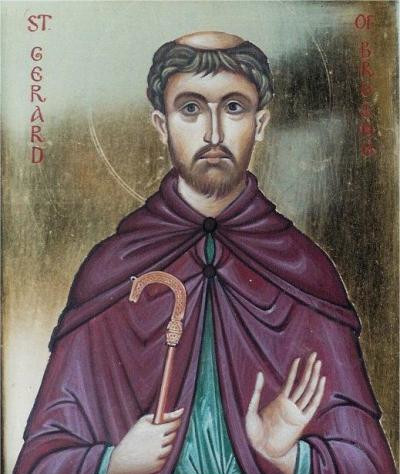
Saint of the Day for 3 October: Saint Gerard of Brogne
Saint Gerard of Brogne: the saint of works of mercy
Name
Saint Gerard of Brogne
Title
Abbot
Birth
End of the 9th century, Namur
Death
03 October 959, Namur
Recurrence
03 October
Martyrology
2004 edition
Prayer
O God, who hast given to thy people St Gerard Abbot, with his help make us strong and persevering in the faith, to collaborate assiduously in the unity of the Church. Through our Lord Jesus Christ, your Son, who is God, and lives and reigns with you, in the unity of the Holy Spirit, for ever and ever. Amen.
Roman Martyrology
In the territory of Namur, in today’s Belgium, Saint Gerard, the first abbot of the monastery of Brogne, which he founded, worked for the renewal of monastic discipline in Flanders and Lotharingia and brought many cenobia back to the original observance of the rule.
The Saint and Mission
St. Gerard of Brogne is a shining example of how spiritual mission can shape not only the life of an individual, but extend to influence entire communities and, indeed, the entire Church. His life and work reflect a mission deeply rooted in a quest for greater holiness and a commitment to monastic reform. In his own time, Gerard recognised a divine vocation that called him to a life of prayer and service. Embracing this call, he immersed himself in a path of deep devotion and monastic discipline. His mission became to re-establish strict monastic observance and to improve the spiritual life not only of his monastery, but of many other monasteries in Belgium and France. St. Gerard’s mission was rooted in his deep conviction that monastic life, lived with authenticity and fervour, could be a shining light in a world often plunged into the darkness of despair and sin. Through his example and leadership, Gerard sought to raise standards of devotion and discipline, emphasising the importance of prayer, contemplation and community. In this endeavour, Saint Gerard embodied a crucial aspect of the Christian mission: that of being salt of the earth and light of the world. His determination to renew monastic life reflects a broader understanding of mission as a journey towards greater holiness and deeper service to God and the Church. St Gerard’s work was not isolated but communitarian. Through his leadership, many monasteries were revitalised, becoming places of fervent prayer and authentic community life. This communitarian transformation represented the tangible realisation of St Gerard’s mission, highlighting how the commitment of a single soul can reverberate through communities and beyond. The story of St Gerard of Brogne reminds us of the dynamic and transformative essence of Christian mission. Through his life, we can see how mission is not just an external task, but an inner journey of transformation and sanctification that, in turn, radiates out into the world, inviting others to join in this pilgrimage towards deeper union with God. In this way, St. Gerard’s mission continues to resonate across the centuries, offering an inspiring vision of how personal fidelity to God’s call can generate waves of spiritual renewal that resonate across communities and eras.
The Saint and Mercy
St Gerard of Brogne is a model of spiritual dedication and community service. His life, often celebrated for its mission of monastic reform, is also a profound expression of Christian mercy, a central attribute of the Gospel message. Mercy, as we know, is that quality that invites us to enter into the sufferings of others, offering help, comfort and understanding. This virtue is well evidenced in the life and work of St Gerard. Through his desire to renew and reform monastic life, Gerard displayed a form of collective mercy. Seeing the monasteries of his time deviating from a life of simplicity and devotion, he moved with corrective love to guide monastic communities towards a renewed observance of rules and a deeper life of prayer. His mercy was not only a response to the spiritual needs of his community, but also a manifestation of God’s love and compassion. Striving to re-establish monastic discipline, Gerard sought to create an environment that better reflected God’s love, mercy and holiness. His efforts to guide monks and nuns towards a holier life can be seen as an act of spiritual mercy, a willingness to enter into the discomfort and confusion of monastic communities to guide them towards the light of God’s truth and love. Moreover, St Gerard, through his leadership and works, also championed the cause of the poor and marginalised. His life of prayer and service was a reflection of God’s mercy, showing a deep commitment to those who were spiritually or materially in need. St Gerard’s mercy is a testimony to the Christian call to live compassionately, responding to the spiritual and material needs of our neighbour. This practice of mercy was not an isolated task, but was integrated into his broader mission of spiritual reform and renewal. The life of St. Gerard of Brogne remains a powerful reminder of the Christian call to mercy, a call that invites us to respond with love and understanding to the challenges and sufferings of our neighbour, thus leading all to a deeper communion with God.
Hagiography
Gerard was born towards the end of the 9th century in the area of Namur, in present-day Belgium. A nobleman by birth, he consecrated his life to the faith and especially to the cause of reforming the monastic order. According to legend, he was told in a vision by St. Peter that the relics of St. Eugene from the famous abbey of Saint-Denis would be transferred to his estate in Brogne and that he himself would live in…
